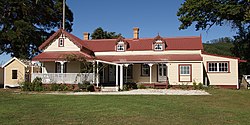Athenree
Athenree is a coastal town in the Western Bay of Plenty District of New Zealand. It is on the northern side of Tauranga Harbour, and separated from Waihi Beach by the Waiau River on its north and east side.[6] The area includes a holiday park with hot springs[7] and Athenree Wetland, which includes a walking track.[8] The settlement was named for Athenry in Country Galway, Ireland by settlers arriving in 1878, including Captain Hugh Stewart (a brother of George Vesey Stewart) and his wife, Adela Blanche Stewart, who wrote a book about her experiences called My Simple Life in New Zealand.[9] The settlement was initially successful due to the 1878 opening of the Martha gold mine in Waihi, and later because of dairy farming.[10] DemographicsStats NZ describes Athenree as a rural settlement, which covers 1.26 km2 (0.49 sq mi).[4] It had an estimated population of 920 as of June 2024,[5] with a population density of 730 people per km2.
 Athenree had a population of 906 in the 2023 New Zealand census, an increase of 102 people (12.7%) since the 2018 census, and an increase of 231 people (34.2%) since the 2013 census. There were 444 males, 459 females, and 3 people of other genders in 345 dwellings.[13] 1.7% of people identified as LGBTIQ+. The median age was 55.0 years (compared with 38.1 years nationally). There were 138 people (15.2%) aged under 15 years, 87 (9.6%) aged 15 to 29, 366 (40.4%) aged 30 to 64, and 315 (34.8%) aged 65 or older.[11] People could identify as more than one ethnicity. The results were 90.7% European (Pākehā); 18.2% Māori; 1.3% Pasifika; 2.0% Asian; 0.7% Middle Eastern, Latin American and African New Zealanders (MELAA); and 2.6% other, which includes people giving their ethnicity as "New Zealander". English was spoken by 98.0%, Māori by 3.0%, and other languages by 4.3%. No language could be spoken by 1.3% (e.g. too young to talk). New Zealand Sign Language was known by 0.3%. The percentage of people born overseas was 19.5, compared with 28.8% nationally.[11] Religious affiliations were 29.5% Christian, 0.3% Hindu, 0.7% Māori religious beliefs, 0.3% Buddhist, 0.3% New Age, and 0.7% other religions. People who answered that they had no religion were 59.6%, and 8.9% of people did not answer the census question.[11] Of those at least 15 years old, 156 (20.3%) people had a bachelor's or higher degree, 414 (53.9%) had a post-high school certificate or diploma, and 201 (26.2%) people exclusively held high school qualifications. The median income was $30,500, compared with $41,500 nationally. 69 people (9.0%) earned over $100,000 compared to 12.1% nationally. The employment status of those at least 15 was 273 (35.5%) full-time, 141 (18.4%) part-time, and 12 (1.6%) unemployed.[11] References
|
||||||||||||||||||||||||||||||||||||||||||||||||||||||||||||||















